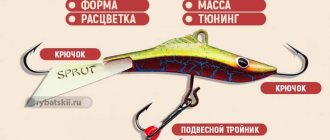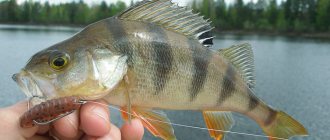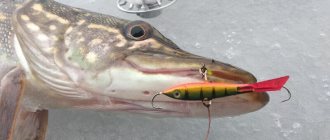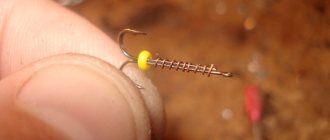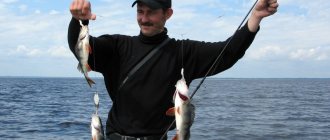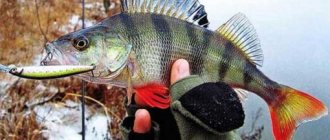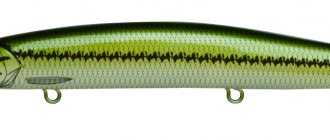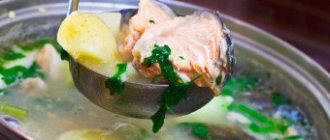It's no secret that perch is the most common and accessible predator in our freshwater bodies. This fish lives in almost all rivers and lakes in large populations and often becomes a targeted object of hunting for spinning anglers. If silicone baits and small spinners designed for catching striped robber are familiar to a wide range of anglers, then the technique of catching perch with a popper is not always clear to the spinning angler and is more associated with hunting for pike. In fact, this type of wobbler shows itself quite well in perch fishing, bringing different-sized fish into the standings, and a spinning angler should focus on the topic of catching perch with this kind of bait.
Fishing with surface wobblers is quite spectacular and interesting with its strategies. The spinner sees with his own eyes the attack of a predator, receiving incredible satisfaction from the process. It is also pleasing that among the many types of wobblers on sale there is a choice of specific baits tuned for perch, and the article presented to his attention will inform the angler about how to understand the problems of selecting a suitable simulator for catching a striped robber, as well as about the secrets of the fishing technology itself.
How to choose a popper for perch
The perch popper has a number of features that distinguish this fishing tool from similar baits designed for hunting other types of predatory fish. First of all, it is the small size of the simulator. After all, perch populations are not distinguished by large specimens, and the capture of even a kilogram trophy is considered a rather serious result of hunting even for an experienced spinning fisherman. Poppers with a length of 3 to 6 cm are considered acceptable sizes for perch bait.
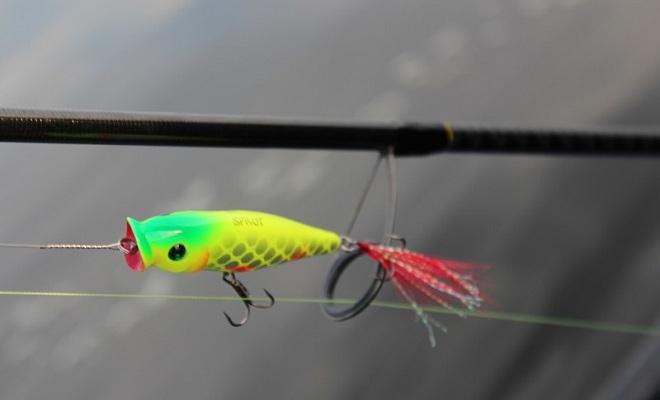
The body of the wobbler is equipped with two tees. As a point of attack, a conspicuously colored, most often scarlet, synthetic thread is mounted on the rear tee of the bait. When guiding the instrument, a gurgling sound is produced, which occurs due to the frontal cup. Perch wobblers are characterized by narrow working surfaces of the cup with a slight deflection. Often, a muffled gurgling sound that is not particularly loud is the best way to force a predator to attack. In addition, such surfaces produce a stream of spray with less intensity without scaring away a school of active fish.
The color of the popper's body has virtually no effect on the frequency of bites, because it is already reliably known that perches react to the movements and noise created by the bait during retrieval. Therefore, when choosing a popper, a fisherman has the right to purchase a bait in a color that pleases only his eye. Miniature bait is mainly caught using ultralight or light spinning tackle, therefore the masses of the simulators are low and fall within the range of 2 to 12 grams.
When and where to use
It is used in areas of the reservoir with shallow depth. Quite often, these areas are distinguished by the presence of a lot of algae, as well as other natural shelters. Here the predator prefers to hide from the sun and hunt.
The first peak of effectiveness of surface baits occurs in late spring. At this time, the predatory fish, having spawned, begins to actively feed. At the same time, they often hunt in the same areas where spawning took place. And such places are usually characterized by shallow depth. The popper in this case imitates small spawning fish. Of course, the predator does not miss the opportunity to feast on such easy prey.
The second peak occurs during the period when it is hot outside. During the summer heat, it is often impossible to attract a predator with any bait. And only a popper at minimal fishing speeds can interest an asp or pike. So if you have tried the usual baits, but there is no result, you should use a popper.
In the first half of autumn, the predator begins to actively feed, preparing for winter. At this time, predatory fish still respond well to surface baits. Again, you need to choose relatively shallow water areas for fishing. But in the second half of autumn it is better not to take this bait out of the box. As the weather gets colder, predatory fish move to deeper areas and become uninteresting.
Recommended reading: How to properly catch pike with mugs
The best poppers for bass
Continuing the article, we will focus on the most popular and widely sold perch baits of this type. Presented in the form of a rating, effective working poppers for perch will not become a burden and dry statistics for the spinning arsenal of lures, but will allow the angler to expand his fishing capabilities, and, consequently, increase his results.
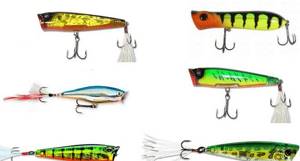
- model will top the rating . This is a powerful 60mm tool for catching trophy croakers. With a weight of seven grams, it has excellent aerodynamic properties and ensures long-distance fishing with precise bait delivery.
- Halco Night Walker nano is no less effective . A miniature 40 mm wobbler weighing about 4 grams creates gurgling sounds and a massive fountain of small splashes that are attractive to predators. Suitable for catching predators of different sizes.
- Third row for ZipBaits ZBL Popper . The model is positioned as a tool for hunting medium and large perch, which is confirmed by practice. When working with a light spinning rod, hard jerking retrieves on short dotted lines are attractive for fish.
- Hacker Slaver Chug from DUO will delight the angler with the ability to manipulate the sounds emitted by the bait when retrieving. Depending on the stroke style, the popper produces a different tonal sound, which expands the boundaries of hunting possibilities. With a length of 65 mm, the bait weighs about 11 grams, which facilitates long and accurate casts when fishing in windy weather. The purpose of the model is to catch trophy perch.
- Daiwa brand, the TD Popper Z model, closes the ranking in fifth position . This light bait measures 65 mm and weighs 6 grams and is equipped with a built-in ratchet that produces a squelching sound. The popper has a high degree of balance, and the true capabilities of the instrument, which realistically resembles a hunting object of a predator, are revealed with soft jerking movements.
How to catch perch with a popper
Fishing for perch with a popper is promising in shallows and in water areas with a high level of aquatic vegetation. The most favorable fishing period is considered to be the summer months and the beginning of autumn.
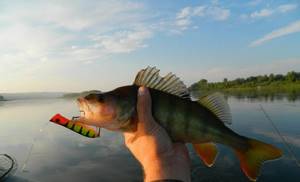
Important! Hunting is successful in the so-called perch boilers, when you can visually notice the accumulation of a predator knocking down the fry into dense schools, which, when attacked by a predator, are frightened and jump out of the water to the surface.
Popper bass fishing can be done from shorelines or from a boat. The main thing is to remain quiet when approaching a promising place, trying not to scare away the hunting predator. When the fish is less active and its presence is not visually observed, then the surface bait is placed in windows of aquatic thickets, on the border of reeds or cattails adjacent to a clear water area and in shallow places of the reservoir with the presence of snags or driftwood at the bottom. Unlike most species of predators, perch can be caught with surface bait throughout the day.
Small-sized specimens of fish come quite close to the shore, so when using a strategy to catch a predator of different sizes, fishing at short distances is justified. When hunting for trophy perch, they fish the middle and far reaches of promising water areas, since large individuals are more cautious and prefer to stay in small groups, and especially large humpback whales generally lead a solitary lifestyle, hunting alone.
Why choose a large popper?
Spinning fishermen, even with experience, are surprised when purchasing bait that its size is often slightly smaller than the perch itself. This is directly related to the fact that this fish is insatiable, it can literally swallow anything. A large mouth helps her in this (sometimes a perch can eat a small shell, but, as a rule, during a hunger strike).
Therefore, it is worth paying attention to the size of the popper. They will increase the possibility of catching larger fish. Why does popper interest perch? The bait method is like playing with feeding fish on the surface of the water. Reflexes are triggered, like the Pavlovian effect, and the fish is hooked. The noise made allows you to attract even more fish, which increases the chance of catching.
Read: Fishing for pike perch on small rivers
Popper wiring
Since the popper is designed for surface fishing of predators, this factor gives a number of advantages to the angler when performing the fishing technique. After all, the spinner clearly sees the trajectory of the bait and the nature of its play at any moment, having the opportunity to correct the animation being performed. The classic presentation of a popper bait is jerking movements with the rod while simultaneously reeling in the free cord, after which the wobbler is given a pause, at which time the bite most often occurs. Depending on the activity of the predator during fishing, jerks can be performed in a sharp aggressive style or in soft, calm pulls with stroke sizes of varying lengths. The pause also adjusts to the mood of the fish.
Important! Short second pauses are justified when fishing for a highly active predator. With passive biting, the tactic of stopping for 7-10 seconds works.
Sharp jerks are accompanied by more intense squelching and a stream of splashes. Quiet wiring is characterized by moderation in the noise level of the bait's movement. From reservoir to reservoir, the preferences of the perch change and the spinning angler needs to be able to move the popper both in a sharp and calm mode, selecting the stroke that is optimal in terms of the number of bites.
Fishing technique
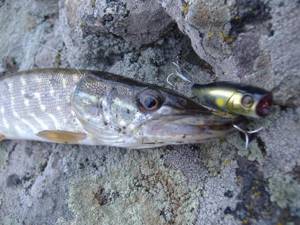
Popper fishing techniques vary widely. It depends on the location, weather, and the mood of the predator. For example, when the pike is active, after casting they make a quick, even aggressive retrieve. The wiring is in many ways reminiscent of the wiring of a minnow-type wobbler when fishing by twitching. Everything is exactly the same here: the bait is pulled with a jerking retrieve.
If the predator is active, then the tracking speed is high, and the number of pauses is reduced to a minimum. They may not exist. In this case, the popper draws a zigzag across the surface of the water, while constantly gurgling. You can also try even wiring. This also works quite often! In this case, the bait silently passes over the surface of the water, and the predator is attracted by the “whiskers” diverging from the bait.
The less active the pike, the lower the speed of the retrieve should be. If the pike does not show itself at all, then you should retrieve it as slowly as possible. After casting, do not immediately rotate the reel handle. You should wait a few seconds until the water around the bait calms down. It is at this moment that a bite may follow. Wiring when fishing for passive pike consists of single jerks followed by pauses of several seconds. The pike ignores the quickly passing bait. But if it is in the visibility zone for a long time, then the predator’s nerves usually give out and a bite occurs.
Wiring should be done near the edges of aquatic vegetation, above underwater edges, near flooded quarries or trees that have fallen into the water. In general, in those places where a predator can find shelter.
Homemade popper
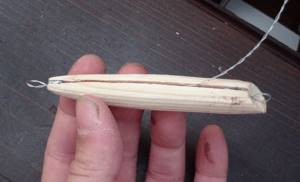
Making a wobbler yourself is not particularly difficult, especially if you already have the skill of fishing with a purchased product and the angler understands the intricacies of a fishing tool that can increase the efficiency of hunting. The easiest way to make a popper is from a vine or willow branch. A workpiece of suitable thickness is freed from the bark and ground to a cone. The frontal part is cut off at a slight angle, with a chisel or knife, cutting out a concavity on the plane, which, when inserted, will produce the sounds inherent in a wobbler. A frame is made from wire, bending loops for hooks and fastening the bait to the cord. Having cut a recess in the lower part of the workpiece, the manufactured wire frame is glued into the wooden body using epoxy resin.
After the epoxy has hardened, the workpiece is sanded with fine abrasive sandpaper, painted in a promising color and equipped with tees, supplying the tail hook with a bright red thread. After assembly, all that remains is to test the bait in practice, which will most likely bring the expected success, because fishing with a spinning rod on a popper for an active perch found in a reservoir rarely remains without results.
Gear selection
Don’t forget about the spinning rod, because casting accuracy depends on it. Before buying a spinning rod for popper fishing, it is better to consult with a specialist. The length of the spinning rod for popper fishing should not exceed 2.5 m. The leash also affects good fishing.
The most suitable type of leash in this case is the number two guitar string.
The fact is that leashes made of elastic materials sooner or later twist and take on the appearance of a spring, which reduces the sensitivity of contact with the bait during cautious bites.
But a string leader does not have this property, which makes it almost the only option when fishing with a popper. In addition, such a leash is very light in weight, which does not affect the action of the bait. It is better to put off the swivel or fastener until the next fishing trip; when fishing with a popper, they do not bring any benefit at all.
Read! Seasonal baits for chub fishing
